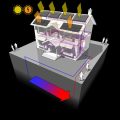1. Introduction to Feng Shui in Modern American Homes
Feng Shui, an ancient Chinese practice, focuses on creating harmony and balance within a living space. Its main goal is to encourage positive energy, or “chi,” by arranging furniture, décor, and even technology in ways that support health, happiness, and prosperity. While Feng Shui has deep roots in Eastern tradition, it has become increasingly popular in American homes—often adapted to fit modern lifestyles and contemporary home designs.
What Is Feng Shui?
At its core, Feng Shui is about how the environment influences your well-being. It considers factors like room layout, light, color, and the flow of movement within a space. In the U.S., people often use Feng Shui as a practical tool for improving comfort and boosting productivity at home.
How Feng Shui Fits Into American Culture
American homes tend to be larger and more open than traditional Chinese homes. As a result, some classic Feng Shui guidelines have been modified. For instance, open-concept layouts require new approaches to balancing energy and creating cozy, inviting spaces.
Common Adaptations of Feng Shui in America
| Traditional Feng Shui Element | Modern American Adaptation |
|---|---|
| Bagua Map (energy map) | Used as a design guide for zoning different activities (work, rest, play) |
| Natural Elements (wood, water, fire) | Integrated with sustainable materials and eco-friendly design |
| Furniture Placement | Adapted for open floor plans and multipurpose rooms |
| Clutter-Free Spaces | Emphasized through minimalism and smart storage solutions |
The Role of Contemporary Design
Today’s American homes feature sleek lines, neutral palettes, and plenty of natural light. These elements actually align well with Feng Shui principles. Open windows invite fresh air; uncluttered rooms encourage free movement; and technology is often used to create an efficient, comfortable environment.
Sustainable Living Meets Smart Home Tech
Sustainability is a growing trend in both American culture and modern interior design. Smart home technology—such as energy-efficient lighting, climate control systems, and automated appliances—can help optimize energy flow while also reducing environmental impact. In this way, smart home tech becomes a natural extension of sustainable Feng Shui practices.
2. Core Principles of Sustainable Feng Shui
Integrating Environmental Awareness
Sustainable Feng Shui goes beyond traditional design by focusing on how our homes interact with the environment. In the U.S., this means choosing eco-friendly materials, reducing waste, and maximizing natural resources. Smart home technology can support these goals by helping homeowners monitor energy use, manage lighting, and control indoor climates more efficiently. For example, smart thermostats adjust heating and cooling based on real-time weather data, reducing energy consumption without sacrificing comfort.
Environmental Awareness in Action
| Aspect | Traditional Feng Shui | Modern Smart Home Application |
|---|---|---|
| Natural Light | Maximize sunlight for positive energy (Qi) | Automated blinds and smart lighting systems optimize daylight usage |
| Air Quality | Encourage fresh air flow through windows and plants | Smart air purifiers and sensors track air quality and filter pollutants automatically |
| Water Conservation | Use water features to promote balance | Smart irrigation systems minimize water waste in landscaping |
Optimizing Energy Flow (Qi) with Technology
The flow of energy, or Qi, is at the heart of Feng Shui. In a sustainable home, energy flow is not just about furniture placement—it’s about creating spaces that feel open, balanced, and healthy. Smart home devices make it easier to adjust layouts and settings to maintain good Qi. Motion-activated lights create inviting pathways, while connected sound systems can play calming music throughout your space, enhancing the atmosphere.
Smart Tools for Better Energy Flow
- Smart Lighting: Adjusts brightness and color temperature to boost mood and productivity.
- Automated Curtains: Opens or closes according to sunlight patterns for natural rhythm.
- Room Sensors: Monitor occupancy and adjust environments to avoid stagnant areas.
Supporting Well-Being in Everyday Life
A sustainable Feng Shui approach nurtures both physical health and emotional well-being. In modern American homes, this means using smart tech to create personalized comfort zones. Air filtration systems improve sleep quality, while app-controlled aromatherapy diffusers add soothing scents when needed. Wellness-focused gadgets encourage mindfulness practices such as meditation or deep breathing exercises—helping families recharge after busy days.
Summary Table: Modern Sustainable Feng Shui Practices
| Sustainable Principle | Traditional Practice | Smart Home Solution |
|---|---|---|
| Environmental Awareness | Select local materials; maximize daylight; conserve water | Eco-friendly appliances; automated lighting; smart irrigation systems |
| Energy Flow (Qi) | Create open pathways; use mirrors to reflect light; avoid cluttered spaces | Motion sensors; smart layout suggestions via apps; automated cleaning robots |
| Well-Being & Comfort | Add plants for fresh air; incorporate calming sounds; use soft textures | Air quality sensors; integrated sound systems; smart thermostat zoning for ideal temperatures |
This integration of smart technology with sustainable Feng Shui principles brings harmony to modern living spaces while supporting a greener lifestyle that fits American needs and values.

3. Smart Home Technology: Features and Benefits
In the United States, smart home technology is quickly becoming a staple in modern households. These innovations not only make daily life more convenient, but they also play a significant role in creating a sustainable and harmonious living environment—values at the core of modern Feng Shui. Let’s take a closer look at some of the most popular smart home solutions and how they can enhance both your lifestyle and the energy flow in your home.
Popular Smart Home Solutions in the U.S.
| Smart Home Solution | Main Features | Benefits for Everyday Living | Feng Shui Impact |
|---|---|---|---|
| Smart Lighting | Remote control, scheduling, color adjustment, energy efficiency | Easy to adjust lighting for comfort and mood; lowers electricity bills | Supports balanced energy (Qi) by adjusting light intensity and color to match time of day and activities |
| Smart Thermostats | Programmable settings, learning routines, remote access, energy tracking | Keeps home comfortable year-round while saving on heating/cooling costs | Maintains optimal temperature for health and well-being; promotes smooth energy flow throughout the space |
| Smart Security Systems | Cameras, motion sensors, door/window alerts, smartphone notifications | Provides peace of mind with real-time monitoring and alerts; deters intruders | Enhances feelings of safety and stability, which are essential elements of good Feng Shui in any home |
| Voice Assistants (e.g., Amazon Alexa, Google Home) | Voice-activated control of devices, reminders, information retrieval | Makes managing household tasks easier and more efficient for busy families | Simplifies routines and reduces stress, supporting calm and positive energy in the household |
| Smart Appliances (refrigerators, washers, etc.) | Remote monitoring, maintenance alerts, energy-saving modes | Saves time and resources by optimizing appliance use and reducing waste | Keeps the home environment clean and clutter-free—important for smooth Qi circulation according to Feng Shui principles |
The Connection Between Smart Tech and Sustainable Feng Shui Living
Integrating these smart technologies into your home does more than just add convenience—it aligns with the goals of sustainable Feng Shui. By optimizing lighting, temperature, security, and daily routines, smart devices help create an environment where you feel comfortable, secure, and energized. As a result, you’re not only embracing cutting-edge technology but also fostering a healthier balance between modern living and traditional Feng Shui wisdom.
4. Aligning Smart Technology with Feng Shui Principles
Bringing Balance and Sustainability into the Modern Home
Incorporating smart home technology into your living space is more than just a modern upgrade—its an opportunity to support both sustainability and harmony, two important principles in Feng Shui. By integrating devices that optimize natural light, improve air quality, and boost energy efficiency, homeowners can create environments that are not only eco-friendly but also energetically balanced.
Optimizing Natural Light
Light is a vital element in Feng Shui, representing life energy or “chi.” Smart lighting systems let you adjust brightness and color temperature throughout the day, helping you mimic natural sunlight indoors. This creates a positive, uplifting atmosphere that supports well-being. For example, automated blinds or curtains can open and close based on the sun’s position, ensuring your home gets plenty of daylight while maintaining privacy and comfort.
Smart Lighting Solutions Table
| Device | Feng Shui Benefit | Sustainability Feature |
|---|---|---|
| Smart Bulbs | Adjustable color and intensity balance energy flow | Energy-efficient LED technology reduces electricity use |
| Automated Blinds | Controls sunlight entry for harmonious spaces | Reduces need for artificial lighting during the day |
| Smart Switches | Easy control of multiple lights for flexible ambiance | Saves energy by scheduling lights to turn off when not needed |
Enhancing Air Quality with Smart Devices
Clean air is crucial for good Feng Shui because it supports clear thinking and healthy living. Smart air purifiers and HVAC systems monitor indoor air quality and adjust automatically to keep your environment fresh. Some devices even alert you when its time to open windows for natural ventilation, connecting you to the outdoors and circulating new chi into your space.
Air Quality Improvement Devices Table
| Device | Main Function | Sustainable Benefit |
|---|---|---|
| Smart Air Purifier | Removes allergens & pollutants; tracks air quality levels | Runs efficiently only when needed, saving power |
| Wi-Fi Connected Thermostat/HVAC System | Keeps optimal temperature & humidity for comfort and balance | Lowers energy usage by learning routines and optimizing heating/cooling schedules |
| Window Sensors & Automation Kits | Sends reminders or opens windows for fresh air when indoor quality drops | Cuts back on mechanical ventilation costs by using natural airflow when possible |
Boosting Energy Efficiency While Supporting Harmony
Energy efficiency aligns with both sustainable living and the Feng Shui idea of minimizing wasteful or stagnant energy. Smart plugs, appliances, and power strips help eliminate “phantom loads” (power drawn by electronics when not in use), while smart thermostats adjust temperatures based on occupancy patterns. These technologies not only cut down utility bills but also foster a sense of orderliness—another core Feng Shui value.
How Smart Tech Enhances Feng Shui at Home:
- Zoning: Use smart lighting to define zones within open-plan homes, creating distinct spaces for relaxation, work, and socializing.
- Avoiding Clutter: Automate routine tasks (like adjusting blinds or turning off lights) to keep spaces neat and free of unnecessary gadgets or switches.
- Nurturing Nature: Pair smart irrigation systems with houseplants to bring vitality into your space without wasting water.
By thoughtfully integrating these technologies, American homeowners can enjoy the best of both worlds: modern convenience and authentic Feng Shui benefits that make every room feel just right.
5. Practical Tips for Blending Smart Tech with Feng Shui
Making Smart Technology Work for Your Feng Shui Goals
Blending smart home technology with the principles of modern, sustainable Feng Shui doesn’t have to be complicated. The key is to use technology intentionally, so it enhances your space’s flow, energy, and comfort—without creating unnecessary clutter or stress. Here are practical ways American homeowners can achieve harmony between smart tech and Feng Shui in their homes.
Focus on Intentional Placement
Where you put your smart devices matters. For example, avoid placing a Wi-Fi router directly in your bedroom or close to your headboard—Feng Shui wisdom suggests keeping electronic energy (or “EMF”) away from your sleeping area. Instead, place routers and hubs in common spaces such as the living room, but out of direct sight if possible.
| Device | Best Placement (Feng Shui) | Smart Tip |
|---|---|---|
| Smart Speakers | Living room corner, away from main entrance | Choose neutral colors that blend with décor |
| Thermostats | Central hallway, not facing front door | Install smart thermostats with minimalist designs |
| Security Cameras | Outside entryways, angled downward | Avoid pointing directly at doors/windows inside the home |
| Smart Lighting Hubs | Main living areas; avoid bedrooms for restful sleep | Select warm-white LED bulbs for a soothing vibe |
Choose Tech That Reduces Clutter and Energy Waste
Sustainable Feng Shui values both environmental harmony and minimalism. Opt for smart devices that help reduce energy consumption—like smart plugs that turn off appliances when not in use or motion-sensor lights that only activate when needed. Use multi-functional devices to cut down on excess gadgets and visible wires.
Real-Life Example:
The Smith family in Seattle installed a single smart hub that controls their lights, thermostat, and security system—all via smartphone. By consolidating devices and hiding cords behind furniture, their living space feels open and calm, aligning with both eco-friendly goals and Feng Shui principles.
Create Zones for Different Activities Using Smart Tech
Good Feng Shui encourages clear zones for rest, work, dining, and relaxation. Use smart lighting to create ambience: cool white light in your home office boosts focus, while dimmable warm lighting in the living room encourages relaxation after work. Smart blinds can automatically adjust to let in natural light during the day and provide privacy at night.
Pro Tip:
Set up “scenes” using your smart home app—for example, a “Morning Energy” scene can gradually brighten lights and play calming music in the kitchen to start your day positively.
Avoid Overloading Your Space with Devices
Treat each new gadget as you would a piece of furniture: Does it serve a purpose? Will it disrupt the flow of your space? It’s better to have fewer high-quality devices than an overload of tech that interrupts energy flow or creates visual clutter.
Checklist for Harmonizing Smart Tech with Feng Shui:
- Keep device cords hidden or organized neatly.
- Select wireless or wall-mounted options when possible.
- Match device colors to your room’s décor palette.
- Avoid placing screens (TVs, tablets) directly across from entryways or beds.
- Purge old tech regularly to keep energy fresh.
Sustainable Practices: Upgrade Mindfully
If you’re upgrading old devices, recycle responsibly through local e-waste programs. Choose ENERGY STAR-certified products and look for brands committed to sustainable manufacturing. This aligns your home technology choices with both environmental stewardship and holistic well-being—a win-win for modern American homeowners embracing sustainable Feng Shui.


